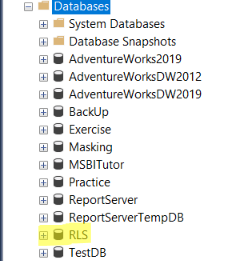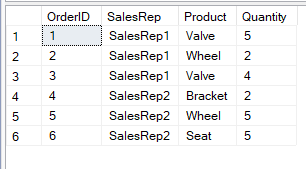Row Level Security In SQL Server
SQL Server Row Level Security
Row-level security (RLS) is a feature added as of SQL Server 2016. Instead of encrypting or decrypting a database’s table data, it restricts and filters a table’s row-level data in accordance with security policies defined by the user. This enables the database engine to limit the number of exposed data rows. This is a simple and powerful SQL Server security control that is transparent to both clients and user applications.
Permissions
Creating, altering, or dropping security policies requires the ALTER ANY SECURITY POLICY permission. Creating or dropping a security policy requires ALTER permission on the schema.
Additionally, the following permissions are required for each predicate that is added:
· SELECT and REFERENCES permissions on the function being used as a predicate.
· REFERENCES permission on the target table being bound to the policy.
· REFERENCES permission on every column from the target table used as arguments.
-- Create databas RLS
CREATE DATABASE RLS
GO
-- Create schema
CREATE SCHEMA Sales
GO
-- Create table
CREATE TABLE Sales.Orders
(
OrderID int,
SalesRep nvarchar(50),
Product nvarchar(50),
Quantity smallint
);
-- Insert records into table
INSERT INTO Sales.Orders VALUES (1, 'SalesRep1', 'Valve', 5);
INSERT INTO Sales.Orders VALUES (2, 'SalesRep1', 'Wheel', 2);
INSERT INTO Sales.Orders VALUES (3, 'SalesRep1', 'Valve', 4);
INSERT INTO Sales.Orders VALUES (4, 'SalesRep2', 'Bracket', 2);
INSERT INTO Sales.Orders VALUES (5, 'SalesRep2', 'Wheel', 5);
INSERT INTO Sales.Orders VALUES (6, 'SalesRep2', 'Seat', 5);
-- View the rows in the table
SELECT * FROM Sales.Orders;
-- Create users
CREATE USER Manager WITHOUT LOGIN;
CREATE USER SalesRep1 WITHOUT LOGIN;
CREATE USER SalesRep2 WITHOUT LOGIN;
GO
-- Before granting read access to users
-- Grant read access on the table to each of the users.
GRANT SELECT ON Sales.Orders TO Manager;
GRANT SELECT ON Sales.Orders TO SalesRep1;
GRANT SELECT ON Sales.Orders TO SalesRep2;
Create a new schema, and an inline table-valued function. The function returns 1 when a row in the SalesRep column is the same as the user executing the query (@SalesRep = USER_NAME()) or if the user executing the query is the Manager user (USER_NAME() = 'Manager').
-- Create new schema as Security
CREATE SCHEMA Security;
GO
-- Create inline function
CREATE FUNCTION Security.tvf_securitypredicate(@SalesRep AS nvarchar(50))
RETURNS TABLE
WITH SCHEMABINDING
AS
RETURN SELECT 1 AS tvf_securitypredicate_result
WHERE @SalesRep = USER_NAME() OR USER_NAME() = 'Manager';
GO
Create a security policy adding the function as a filter predicate. The state must be set to ON to enable the policy.
-- Create a security policy
CREATE SECURITY POLICY SalesFilter
ADD FILTER PREDICATE Security.tvf_securitypredicate(SalesRep)
ON Sales.Orders
WITH (STATE = ON);
GO
-- Allow SELECT permissions to the fn_securitypredicate function
GRANT SELECT ON Security.tvf_securitypredicate TO Manager;
GRANT SELECT ON Security.tvf_securitypredicate TO SalesRep1;
GRANT SELECT ON Security.tvf_securitypredicate TO SalesRep2;
-- Now test the filtering predicate, by selected from the Sales table as each user
EXECUTE AS USER = 'SalesRep1';
SELECT * FROM Sales.Orders;
REVERT;
EXECUTE AS USER = 'SalesRep2';
SELECT * FROM Sales.Orders;
REVERT;
EXECUTE AS USER = 'Manager';SELECT * FROM Sales.Orders;
REVERT;
-- Disable the policyALTER SECURITY POLICY SalesFilter
WITH (STATE = OFF);
Now Sales1 and Sales2 users can see all six rows.
EXECUTE AS USER = 'SalesRep1';
SELECT * FROM Sales.Orders;
REVERT;
EXECUTE AS USER = 'SalesRep2';
SELECT * FROM Sales.Orders;
REVERT;
-- Connect to the SQL database to clean up resources
DROP USER SalesRep1;
DROP USER SalesRep2;
DROP USER Manager;
DROP SECURITY POLICY SalesFilter;
DROP TABLE Sales.Orders;
DROP FUNCTION Security.tvf_securitypredicate;
DROP SCHEMA Security;
DROP SCHEMA Sales;
















Thanks for your feedback
ReplyDeleteVery good article thanks for sharing
ReplyDelete